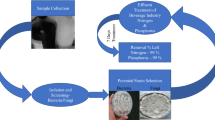Abstract
Biotechnological processes have the potential to reduce environmental pollution through their application in processes aimed at resolving waste dumping problems. In this study, Bacillus cereus was assessed for its efficiency to decolorize pulp and paper industrial effluents. The impact of carbon source, nitrogen source, temperature, initial pH and incubation period on color reduction was also studied. The optimum pH and temperature were found to be 6.5 and 45 °C, respectively. B. cereus was efficient at decolorizing the effluents in the presence of glucose, xylose and starch (84, 45.5 and 66 %, respectively), but maximum color reduction (90.6 %) was obtained with 0.5 % sucrose as the carbon source in the presence of 1 % ammonium sulphate. The substantially high load of chemical oxygen demand and biological oxygen demand was decreased by about 61 and 66 %, respectively, by B. cereus. The molecular size distribution studies of control and bacterial-treated effluent samples revealed the degradation of high and medium molecular mass compounds. The results demonstrate the high potential of B. cereus as a significant candidate for color removal from pulp and paper mill effluents.






Similar content being viewed by others
References
Ali F, Sarma TC, Saikia CN (1993) Pulp and paper from certain fast-growing plant species. Bioresour Technol 45:65–67
Bajpai P, Bajpai PK (1994) Biological color removal of pulp and paper mill waste waters. J Biotechnol 33:211–220
Belsare DK, Prasad DY (1988) Decolorization of effluent from the bagasse-based pulp mills by white-rot fungus, Schizophyllum commune. Appl Microbiol Biotechnol 28:301–304
Blaga A, Avramova T, Stefanova L, Mutafov S (2008) Temperature effect on bacterial azo bond reduction kinetics: an arrhenius plot analysis. Biodegradation 19:387–393
Chandra R, Abhishek A, Sankhwar M (2011) Bacterial decolorization and detoxification of black liquor from rayon grade pulp manufacturing paper industry and detection of their metabolic products. Bioresour Technol 102:6429–6436
Galai S, Limam F, Marzouki MN (2010) Decolorization of an industrial effluent by free and immobilized cells of Stenotrophomonas maltophilia AAP56. Implementation of efficient down flow column reactor. W J Microbiol Biotechnol 26:1341–1347
Gannon RW, Osmond DL, Humenik FJ, Gale JA, Spooner J (1996) Goal-oriented agricultural water quality legislation. Water Resour Bull 32:437–450
Giwa A, Giwa FJ, Ifu BJ (2012) Microbial decolourization of an anthraquinone dye C.I. reactive blue 19 using Bacillus cereus. Am Chem Sci J 2(2):60–68
Jadhav SU, Jadhav MU, Kagalkar AN, Govindwar SP (2008) Decolorization of Brilliant Blue G dye mediated by degradation of the microbial consortium of Galactomyces geotrichum and Bacillus sp. J Chin Inst Chem Eng 39:563–570
Jung H, Pauly D (2011) Water in the pulp and paper industry. Treatise Water Sci 4:667–683
Katal R, Pahlavanzadeh H (2011) Influence of different combinations of aluminum and iron electrode on electrocoagulation efficiency: application to the treatment of paper mill waste water. Desalination 265:199–205
Krahe M, Antranikian G, Markl H (1996) Fermentation of extremophilic microorganisms. FEMS Microbiol Rev 18:271–285
Leitao AL (2009) Potential of Penicillium species in the bioremediation field. Int J Environ Res Public Health 6:1393–1417
Lodato A, Alfieri F, Olivieri G, Di Donato A, Marzocchella A, Salatino P (2007). Azo-dye conversion by means of Pseudomonas sp. OX1. Enzyme Microb Technol 41:646–652
Mehna A, Bajpai P, Bajpai PK (1995) Studies on decolorization of effluent from a small pulp mill utilizing agriresidues with Trametes versicolor. Enzyme Microb Technol 17:18–22
Mishra M, Thakur IS (2010) Isolation and characterization of alkalotolerant bacteria and optimization of process parameters for decolorization and detoxification of pulp and paper mill effluent by Taguchi approach. Biodegradation 21:967–978
Nagarathamma R, Bajpai P, Bajpai PK (1999) Studies on decolorization, degradation and detoxification of chlorinated lignin effluents by Ceriporiopsis subvermispora. Process Biochem 34:939–948
Oliveira PL, Duarte MCT, Ponezi AN, Durrant LR (2009) Use of Bacillus pumilus CBMAI 0008 and Paenibacillus sp. CBMAI 868 for color removal from paper mill effluent. Braz J Microbiol 40:818–826
Prasad DY, Joyce TW (1991) Color removal from kraft bleach plant effluent by Trichoderma sp. Taappi 74:165–169
Pokhrel D, Viraraghavan T (2004) Treatment of pulp and paper mill wastewater. Sci Total Environ 333:37–58
Ragunathan R, Swaminathan K (2004) Biological treatment of a pulp and paper industry effluent by Pleurotus spp. World J Microbiol Biotechnol 20:389–393
Sahoo DK, Gupta R (2005) Evaluation of ligninolytic microorganisms for efficient decolorization of a small pulp and paper mill effluent. Process Biochem 40:1573–1578
Saleem M, Rehman A, Yasmin R, Munir B (2012) Biochemical analysis and investigation on the prospective applications of alkaline protease from a Bacillus cereus strain. Mol Biol Rep 39:6399–6408
Saritha V, Maruthia YA, Mukkanti K (2010) Potential of bioremediation of industrial effluents. Bioresources 5:8–22
Selvam K, Swaminathan K, Song MH, Chae KS (2002) Biological treatment of a pulp and paper industry effluent by Fomes lividus and Trametes versicolor. World Microbiol Biotechnol 18:523–526
Singh S, Chandra R, Patel DK, Reddy MMK, Rai V (2008) Investigation of the biotransformation of pentachlorophenol and pulp paper mill effluent decolorisation by the bacterial strains in a mixed culture. Bioresour Technol 99:5703–5709
Tarek SJ, Montaser YG, Ibrahim ES, Eglal RS, Rabab AN (2011) Comparative study among different photochemical oxidation processes to enhance the biodegradability of paper mill waste water. J Hazard Mater 185:353–358
Taseli BK (2008) Fungal treatment of hemp-based pulp and paper mill wastes. Afr J Biotechnol 7:286–289
Tiku DK, Kumar A, Chaturvedi R, Makhijani SD, Manoharan A, Kumar R (2010) Holistic bioremediation of pulp mill effluents using autochthonous bacteria. Int Biodeterior Biodegrad 649:173–183
Zimmermann W (2002) Degradation of lignin by bacteria. J Biotechnol 13:119–130
Author information
Authors and Affiliations
Corresponding author
Rights and permissions
About this article
Cite this article
Saleem, M., Ahmad, S. & Ahmad, M. Potential of Bacillus cereus for bioremediation of pulp and paper industrial waste. Ann Microbiol 64, 823–829 (2014). https://doi.org/10.1007/s13213-013-0721-y
Received:
Accepted:
Published:
Issue Date:
DOI: https://doi.org/10.1007/s13213-013-0721-y




